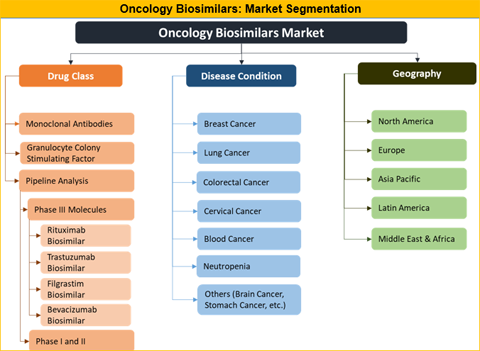The latest market report published by Credence Research, Inc. “Oncology Biosimilars Market – Growth, Future Prospects, Competitive Analysis, 2018 – 2026,” the global oncology biosimilars market was valued at US$ 1,651.5 Mn in 2017 expanding at a CAGR of 28.3% from 2018 to 2026.
Browse the full report Oncology Biosimilars Market – Growth, Future Prospects, Competitive Analysis, 2018 – 2026 report at https://bit.ly/2AcYtQp
Market Insights
According to the U.S. Food and Drug Administration (FDA), biosimilar is a biological product that is highly similar to an existing, approved reference product and has no clinically meaningful differences. Biosimilars are approved according to the same standards of pharmaceutical quality, safety and efficacy that apply to all biological medicines.
The number of biosimilar approvals soared in the United States as five of nine approved biosimilars across different disease conditions received US FDA approval. Furthermore, US Attested the approvals of oncology biosimilarly as Amgen’s Mvasi (bevacizumab-awwb), a biosimilar to Genentech’s Avastin for the treatment of lung, colorectal, kidney, brain and cervical cancers; and Mylan’s Ogivri (trastuzumab-dkst), a biosimilar to Herceptin for treating breast cancer, gastric cancer, and gastrointestinal cancer.
The USFDA is determined to increase biosimilar approvals, especially for cancer as cancer treatment. Although the prices of oncology biosimilars are less than twice as much, the savings are not on the same scale as compared to patented non-biological drugs. Savings of 20% – 30% compared to the reference biologic products have been studied in major markets such as Europe and North America, making biosimilar as a lucrative alternative.
Download Free Request Sample: https://bit.ly/2RV6ZgL
In terms of drug class, the granulocyte colony-stimulating factor (G-CSF) is the largest member of the oncology biosimilars market owing its early approvals in Europe and US, however, monoclonal antibodies class expected to grow at a high rate of growth and emerge as the largest market in 2026 due to recent approvals of Mvasi (bevacizumab-awwb) and Ogivri (trastuzumab-dkst) in the United States. Moreover, robust pipeline and patent expiration of major biologics during the forecast period would further assist the market growth of monoclonal antibodies.
In terms of disease condition, neutropenia is the market due to approvals of filgrastim and peg-filgrastim to multiple pharmaceutical companies in Europe and Asia Pacific. However, breast cancer is projected to proliferate at a humungous rate due to high prevalence of breast cancer globally and recent approval of trastuzumab in Europe and North America.
Europe dominated the global oncology biosimilars market in 2017 due to the presence of approved oncology biosimilar search as filgrastim, trastuzumab and rituximab in the region. Moreover, the European Medicines Agency (EMA) has put forward guidelines for the approval of biosimilars through regulatory bodies as well as the European Society of Medical Oncology (ESMO). Biosimilars and vigorous pipeline expected to hit the market during the forecast period.
The prominent players engaged in the oncology biosimilars market are Samsung Bioepis, Celltrion Inc., Biocon, dr. Reddy’s Laboratories Ltd., Intas Pharmaceuticals Ltd., STADA Arzneimittel AG, Pfizer Inc., Sandoz Inc., Teva Pharmaceutical Industries Ltd., Apotex Inc., and BIOCAD. Robust pipeline and ongoing clinical trials in US and Europe are driving the oncology biosimilars market. For instance, Pfizer has six biosimilars in phase III of clinical trials, testing for drugs such as Rituxan / MabThera, Herceptin, Avastin and Humira
Key Market Movements:
- Rising prevalence of cancer worldwide
- Recent FDA approved biosimilars contributing to the growth of oncology biosimilars market
- Patent expirations of major biologics leading to the inclusion of generic pharmaceuticals companies to venture into biosimilars
- Partnerships and collaboration between biopharmaceutical companies to increase research and development of biosimilars
- Robust pipeline of oncology biosimilars anticipated to enter the market by 2020 thus wants to assist market growth
[For a bigger picture try FREE sample of this report now!]
Table of Content:
Chapter 1. Preface
1.1. Report Description
1.1.1. Study Purpose
1.1.2. Target Audience
1.1.3. USP and Key Offerings
1.2. Research Scope
1.3. Research Methodology
1.3.1. Phase I – Secondary Research
1.3.2. Phase II – Primary Research
1.3.3. Phase III – Expert Panel Review
1.3.4. Assumptions
1.4. Market segmentation
Chapter 2. Executive Summary
2.1. Global Oncology Biosimilars Market Portraiture
2.2. Global Oncology Biosimilars Market, by Drug Class, 2017 (US $ Mn)
2.3. Global Oncology Biosimilars Market, by Disease Condition, 2017 (US $ Mn)
2.4. Global Oncology Biosimilars Market Share, by Geography, 2017 (US $ Mn)
Chapter 3. Oncology Biosimilars: Market Dynamics and Outlook
3.1. Market Overview
3.2. Drivers
3.3. Challenges
3.4. Opportunities
3.5. Attractive Investment Proposition, by Geography, 2017
3.6. Competitive Analysis: Global Oncology Biosimilars Market, by Key Players, 2017

